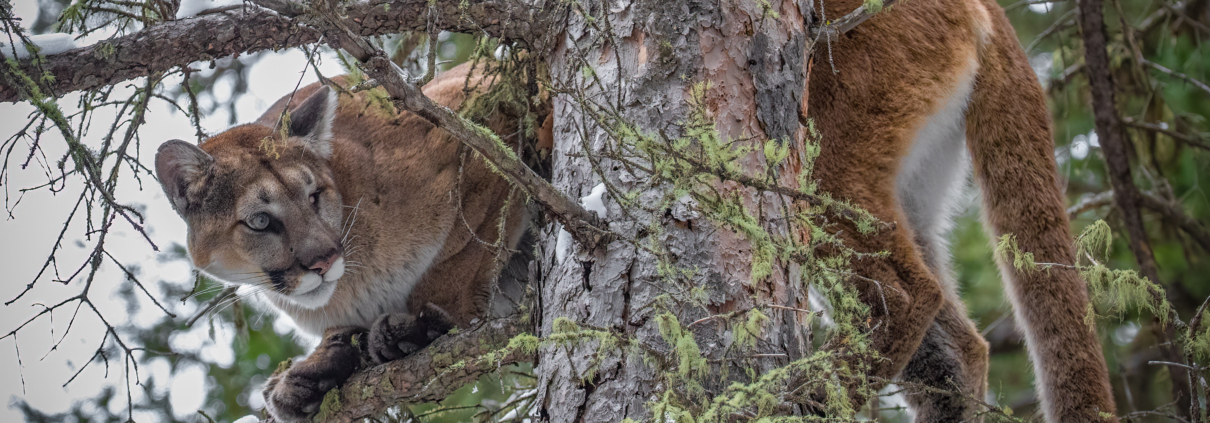Alberta Cougar Hunting Debate: Is There Any Truth?
The narrative surrounding two orphaned cougar kittens, allegedly left motherless due to a hunt near Canmore, has sparked significant public discourse. However, upon closer examination, the evidence supporting this claim appears tenuous and riddled with inconsistencies.
John E. Marriott, a prominent voice in this debate, claimed to have tracked the cougar for four years. Yet, an assessment of the animal’s age using the gum-line recession method revealed the cougar was only three years old, undermining Marriott’s assertion. Marriott also suggested that cougar hunting exacerbates human-cougar conflicts, a claim refuted by a comprehensive literature1 review conducted by 13 experts across multiple U.S. state agencies. This review found no evidence to support the notion that hunting increases such conflicts. In fact, a scientific study2 comparing cougars on the Nevada-California border demonstrated that pursuit by hounds, whether lethal or not, deterred juvenile cougars from approaching human-occupied areas. Another recently published cougar aversion study3 from Washington state using hounds noted similar beneficial outcomes reducing human-cougar conflict.
Marriott further argued against hunting female cougars and the use of hounds, citing ethical and conservation concerns. However, studies in the U.S.4 indicate that in states like Colorado, where hounds are used to tree and identify the sex of mountain lions, the proportion of females in the annual harvest is well below the target set by wildlife biologists. Conversely, states that prohibit hound hunting see a significantly higher female harvest proportion.
The claim that hunters knowingly killed a kitten-bearing female cougar lacks substantiation. Interviews with hunters present during the February hunt revealed no kittens accompanying the cougar at the time. Marriott was reportedly not at the location where the hunt took place around the time of the hunt, and the female cougar was judged by an experienced hunter not to be nursing or bearing kittens, a conclusion supported by postmortem examination of her teats. Furthermore, evidence suggests the cougar had never reproduced, aligning with her estimated age of three years.
Discrepancies also arise in the kittens’ age. Marriott claimed they were three months old, verified by “experts,” while the zoo determined their age to be six months. Research5 indicates orphaned kittens around this age have a 71% survival rate, challenging the narrative of their imminent demise. In my opinion, these kittens should have been given the benefit of the doubt and left in the wild. As one cougar expert reported to me that they were living in an incredibly prey rich environment especially rich in small prey that can easily be caught by a young cougar.
Marriott’s assertion that the hunter was an American paid by the Wild Sheep Foundation is demonstrably false. Interviews with the Presidents of the Wild Sheep Foundation and its Alberta chapter confirmed no financial compensation was provided for this hunt. Additionally, there are no bounties for cougar in Alberta.
The absence of DNA evidence linking the kittens to the hunted cougar further weakens the claim. Deductive reasoning suggests alternative explanations for the kittens’ presence in the area: their mother could have died naturally, in an accident, while hunting prey or they were not orphans. Research6 shows female cougars will spend significant time away from their kittens when they are this age, sometimes over a kilometer apart, particularly during the mid-day hours when this hunt occurred.
The broader context of cougar conservation in Alberta reveals a progressive history of sustainable management practices. Fluctuations in cougar mortality rates are influenced by natural variables and government policies, with no political party demonstrating a vested interest in unsustainable practices. Alberta’s approach to cougar conservation has incrementally improved cougar abundance and distribution over the past century, ensuring their populations remain stable despite modest hunting activities.
In conclusion, the narrative that hunters knowingly killed the kittens’ mother appears to be based on spurious evidence. Alberta’s cougar conservation efforts, rooted in sustainable use and public engagement, continue to support healthy cougar populations. While the story has garnered attention and financial or political gains for some individuals, it is essential to ground public discourse in verified evidence and balanced perspectives.
References
1 Human-Cougar Interactions Science Review Team. 2022. Human-Cougar Interactions: A Literature Review Related to Common Management Questions. Washington Department of Fish and Wildlife, Olympia, Washington, USA. 78 pp.
2 Impacts of management practices on habitat selection during juvenile mountain lion dispersal. 2024. Randolph, J.F., et. al. Ecology and Evolution.
3 Evaluating the Efficacy of Aversive Conditioning of Mountain Lions with Hounds. 2024. Parsons, M.A., et. al. Canadian Wildlife Biology & Management. Special Issue on Mountain Lion Conservation and Management. CWBM 2024: Volume 13, Number 2. ISSN: 1929–3100
4 Mountain Lion – Statistics. Colorado Parks & Wildlife. Why is hound hunting for lions used as a management tool? WWW Document. https://cpw.state.co.us/hunting/mountain-lion/statistics#4257225834-1672976445 Accessed February 16, 2025.
5 Mountain Lion Identification Course. Mortality in Kittens pp 4. Montana Fish, Wildlife & Parks. WWW Document. 11-13-09MountainLionEducationAndIdentification.indd Accessed March February 24th, 2025.
6 The amount of time female pumas Puma concolor spend with their kittens. 2008. Laundre, J.W., Hernandez, L. Wildlife Biology. Vol 14, Issue 2. June 2008. Pages 221-227.
Photo credit © Darryn Epp



